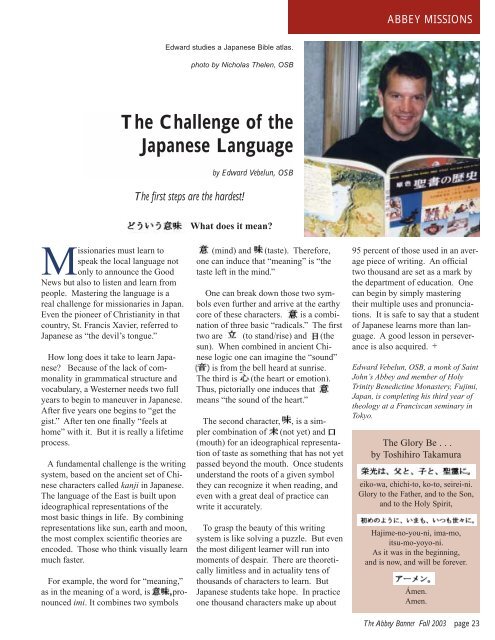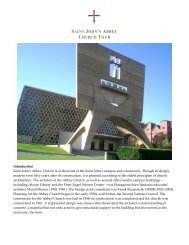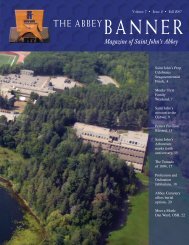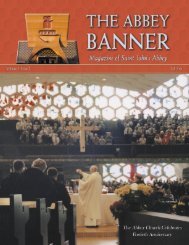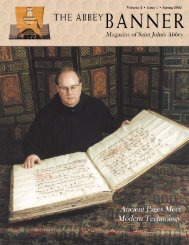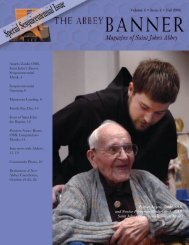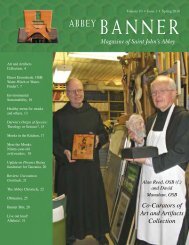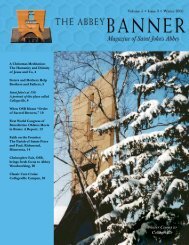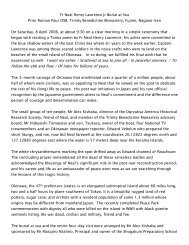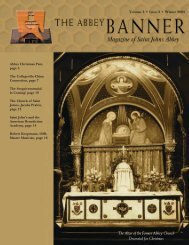Monks and Students Meet the Monks - St. John's Abbey
Monks and Students Meet the Monks - St. John's Abbey
Monks and Students Meet the Monks - St. John's Abbey
You also want an ePaper? Increase the reach of your titles
YUMPU automatically turns print PDFs into web optimized ePapers that Google loves.
Missionaries must learn to<br />
speak <strong>the</strong> local language not<br />
only to announce <strong>the</strong> Good<br />
News but also to listen <strong>and</strong> learn from<br />
people. Mastering <strong>the</strong> language is a<br />
real challenge for missionaries in Japan.<br />
Even <strong>the</strong> pioneer of Christianity in that<br />
country, <strong>St</strong>. Francis Xavier, referred to<br />
Japanese as “<strong>the</strong> devil’s tongue.”<br />
How long does it take to learn Japanese?<br />
Because of <strong>the</strong> lack of commonality<br />
in grammatical structure <strong>and</strong><br />
vocabulary, a Westerner needs two full<br />
years to begin to maneuver in Japanese.<br />
After fi ve years one begins to “get <strong>the</strong><br />
gist.” After ten one fi nally “feels at<br />
home” with it. But it is really a lifetime<br />
process.<br />
A fundamental challenge is <strong>the</strong> writing<br />
system, based on <strong>the</strong> ancient set of Chinese<br />
characters called kanji in Japanese.<br />
The language of <strong>the</strong> East is built upon<br />
ideographical representations of <strong>the</strong><br />
most basic things in life. By combining<br />
representations like sun, earth <strong>and</strong> moon,<br />
<strong>the</strong> most complex scientifi c <strong>the</strong>ories are<br />
encoded. Those who think visually learn<br />
much faster.<br />
For example, <strong>the</strong> word for “meaning,”<br />
as in <strong>the</strong> meaning of a word, is , pronounced<br />
imi. It combines two symbols<br />
Edward studies a Japanese Bible atlas.<br />
photo by Nicholas Thelen, OSB<br />
The Challenge of <strong>the</strong><br />
Japanese Language<br />
The fi rst steps are <strong>the</strong> hardest!<br />
by Edward Vebelun, OSB<br />
What does it mean?<br />
(mind) <strong>and</strong> (taste). Therefore,<br />
one can induce that “meaning” is “<strong>the</strong><br />
taste left in <strong>the</strong> mind.”<br />
One can break down those two symbols<br />
even fur<strong>the</strong>r <strong>and</strong> arrive at <strong>the</strong> earthy<br />
core of <strong>the</strong>se characters. is a combination<br />
of three basic “radicals.” The fi rst<br />
two are (to st<strong>and</strong>/rise) <strong>and</strong> (<strong>the</strong><br />
sun). When combined in ancient Chinese<br />
logic one can imagine <strong>the</strong> “sound”<br />
is from <strong>the</strong> bell heard at sunrise.<br />
The third is (<strong>the</strong> heart or emotion).<br />
Thus, pictorially one induces that<br />
means “<strong>the</strong> sound of <strong>the</strong> heart.”<br />
The second character, , is a simpler<br />
combination of (not yet) <strong>and</strong><br />
(mouth) for an ideographical representation<br />
of taste as something that has not yet<br />
passed beyond <strong>the</strong> mouth. Once students<br />
underst<strong>and</strong> <strong>the</strong> roots of a given symbol<br />
<strong>the</strong>y can recognize it when reading, <strong>and</strong><br />
even with a great deal of practice can<br />
write it accurately.<br />
To grasp <strong>the</strong> beauty of this writing<br />
system is like solving a puzzle. But even<br />
<strong>the</strong> most diligent learner will run into<br />
moments of despair. There are <strong>the</strong>oretically<br />
limitless <strong>and</strong> in actuality tens of<br />
thous<strong>and</strong>s of characters to learn. But<br />
Japanese students take hope. In practice<br />
one thous<strong>and</strong> characters make up about<br />
ABBEY MISSIONS<br />
95 percent of those used in an average<br />
piece of writing. An offi cial<br />
two thous<strong>and</strong> are set as a mark by<br />
<strong>the</strong> department of education. One<br />
can begin by simply mastering<br />
<strong>the</strong>ir multiple uses <strong>and</strong> pronunciations.<br />
It is safe to say that a student<br />
of Japanese learns more than language.<br />
A good lesson in perseverance<br />
is also acquired.<br />
Edward Vebelun, OSB, a monk of Saint<br />
John’s <strong>Abbey</strong> <strong>and</strong> member of Holy<br />
Trinity Benedictine Monastery, Fujimi,<br />
Japan, is completing his third year of<br />
<strong>the</strong>ology at a Franciscan seminary in<br />
Tokyo.<br />
The Glory Be . . .<br />
by Toshihiro Takamura<br />
eiko-wa, chichi-to, ko-to, seirei-ni.<br />
Glory to <strong>the</strong> Fa<strong>the</strong>r, <strong>and</strong> to <strong>the</strong> Son,<br />
<strong>and</strong> to <strong>the</strong> Holy Spirit,<br />
Hajime-no-you-ni, ima-mo,<br />
itsu-mo-yoyo-ni.<br />
As it was in <strong>the</strong> beginning,<br />
<strong>and</strong> is now, <strong>and</strong> will be forever.<br />
Ámen.<br />
Amen.<br />
The <strong>Abbey</strong> Banner Fall 2003 page 23


